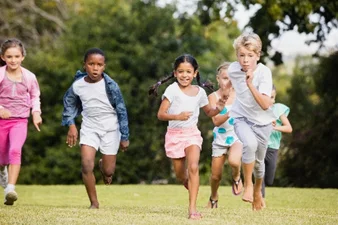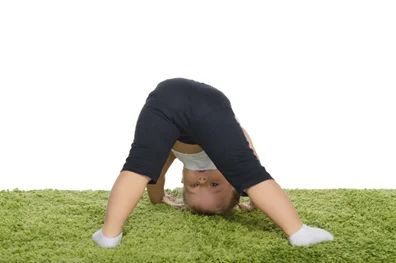HOW TO ENCOURAGE KIDS TO BE PHYSICALLY ACTIVE

Did you know that only about 1 in 4 children get the recommended 60 minutes of physical activity per day? The amount of physical activity children need depends on their age. Children ages 3 through 5 years need to be active throughout the day. Children and adolescents ages 6 through 17 need to be active for 60 minutes every day. The activity should be age-appropriate and fun, and kids don’t need to fit it all in at once: They can add up physical activity throughout the day, in short bursts of 10 minutes or longer.Recommended Guidelines for Physical ActivityAges 3 Through 5 Years
- Be physically active throughout the day for growth and development.
- Adult caregivers should encourage children to be active when they play. .
Ages 6 Through 17 Years
- 60 minutes or more of moderate-to-vigorous intensity physical activity each day.
- Aerobic activity: Most of the daily 60 minutes should include activities like walking, running, or anything that makes their hearts beat faster. At least 3 days a week should include vigorous-intensity activities.
- Muscle-strengthening: Includes activities like climbing or doing push-ups, at least 3 days per week.
- Bone-strengthening: Includes activities such as jumping or running, at least 3 days per week.
As a parent, you can help shape your child’s attitudes and behaviors regarding physical activity. When most adults think about exercise, they imagine working out in the gym, running on a treadmill, or lifting weights. But for kids, exercise means playing and being physically active.
The 3 Elements of Fitness
If you have ever watched kids on a playground, you've seen the 3 elements of fitness in action- Endurance, Strength and Flexibility.
Endurance

Endurance develops when kids regularly get aerobic activity. During aerobic exercise, large muscles are moving, the heart beats faster, and a person breathes harder. Aerobic activity strengthens the heart and improves the body's ability to deliver oxygen to all its cells. Examples of activities that develop endurance include: walking, jogging, biking, hiking, rowing, cross country skiing, stair climbing, basketball, soccer, skating.
Strength

Strength does not have to be limited to lifting weights. Kids can do push-ups, stomach crunches, pull-ups, and other exercises to help tone and strengthen muscles. They also improve their strength when they climb, do a handstand, or wrestle. Muscle strengthening and aerobic exercises like running, jumping, and hopping, also help build strong bones.
Flexibility

Flexibility is improved with stretching exercise by allowing muscles and joints to bend and move easily through their full range of motion. Dance, yoga, and martial arts, like karate, are examples of flexibility activities
Health Benefits of Physical Activity for Kids
- Academic Performance - Improves attention and memory
- Brain Health – Reduces risk of depression
- Muscular Fitness – Builds strong muscles and endurance
- Heart and Lung Health – Improves blood pressure and aerobic fitness
- Cardiometabolic Health – Helps maintain normal blood sugar levels
- Long-term Health – Reduces risk of several chronic diseases, including type 2 diabetes and obesity
- Bone Strength – Strengthens bones
- Healthy Weight – Helps regulate body weight and reduce body fat
Tips to encouraging kids to be Physically Active

Emphasize fun. Help your child find a sport that she enjoys. The more they enjoy the activity, the more likely they will be to continue it. Get the entire family involved. It is a great way to spend time together.
Choose an activity that is developmentally appropriate- take into account your child’s skill level before choosing an activity. Nothing ruins the fun faster, than a frustrated child and parent.
Educate You Child about the Benefits
It is important to educate kids on why physical activity should be a priority. There are age-appropriate ways to let them know the benefits of physical activity. It is always good to have a reason other than “because I said so” when telling your child something is important. However, keep in mind that the conversations you have about physical activity and fitness centered on the health benefits, and not on looking a certain way or losing weight
Start Slow
If your chuld is very inactive now, start slowly. Increase the amount and intensity of activity gradually each week or so. This may help them avoid discomfort or injury and adjust to a more active lifestyle without becoming discouraged.
Make sure you are working your way up towards harder physical activities. Not starting with small goals is what causes most people to fail. Some experts even suggest starting with a 2-Minute Rule. That is, when developing a new walking, water, or workout habit, tell yourself you are just going to do it for 2 minutes. Build from there.
Give gifts that promote physical activity.
Rollerblades, bicycles, ice skates, soccer balls and even active-play video games make great gifts that promote physical activity. Activity-tracking apps and technologies also are fun choices for kids.
Limit Screen Time
One of the best ways to get kids to be more active is to limit the amount of time spent in sedentary activities, especially watching TV and using phones. The Centers for Disease Control and Prevention (CDC) reports the average daily hours by age group:
- 8-10 years old: Six hours
- 11-14 years old: Nine hours
- 15-18 years old: Seven and 1/2 hours
- 60% of teens report being addicted to their cell phone.
Be a Role Model
Your child is more likely to be physically active if you make physical activity a family priority. Take a family bike ride or walk together, or play catch in the yard. Let your children see that you make physical activity a priority in your own daily habits. Fun Ways to Incorporate More Physical Activity Each Day
Visit the playground
On a playground, kids will run, climb stairs, strengthen muscles on the monkey bars and have fun interacting with other kids.
Take a Nature Hike
If your child is artistic, consider a nature hike to collect leaves and rocks for use in a collage.
Walk to the Nearest Library
If your child loves reading, walk or bike to a local library for a book
Have a Dance Party
Music is the best ally to get kids moving to the rhythm of upbeat tunes, and YouTube is a good source to find music: From choreographed children’s songs to Zumba classes, kids of all ages can enjoy spending time dancing to popular songs.
Yoga for kids
Practicing yoga is an activity that allows children to get to know their body, learn to control it, and get to learn a little meditation while playing.
Though it might sound intimidating at first to teach kids how to do yoga, there are tons of videos kids can follow along with that make the whole activity a fun exercise that keeps them engaged.
Balloon Ball
An inflated balloon is an excellent incentive to encourage children to move. This game would consist of trying to pass the balloon between two or more people or between two teams while trying not to let it fall to the ground. Or, simply blow up some balloons and tell the kids to keep the balloons from touching the floor.
Make an Activity Bucket List
Brainstorm with your kids ways to be active and create a Bucket List. Hang it on the refridgerator and mark off activities as you do them. It isa great way to get kids to try new activities.
Think outside the playing field
Not everyone likes organized sports such as soccer or baseball. Look for other activities your child will enjoy — like dancing, rock climbing, swimming, or martial arts. It may take some trial and error before your kid finds the right fit.
Keep trying different ideas until something clicks. It is important to make non-athletic kids motivated and moving so they can enjoy a lifelong habit of physical activity.
Join in the game.
Kids love it when their parents play with them. Have more outdoor activities planned with the family, which helps lighten up their mood, makes them feel relaxed and comfortable. If you have a pet, take him along with your child on hiking or do some gardening activity together, which in turn makes your child feel re-energized. Encourage children’s fitness by taking a family hike. Have a game of catch. Walk or bike to school together—play hopscotch. You don’t need a lot of fancy equipment or special classes to encourage your child to exercise. This is the best tip on how to make lazy child active.
Take a walk before or after dinner Add Fitness Breaks to your favorite show
Turn commercial breaks into fitness breaks when you are watching tv. (Just enough time to have a push-up or jumping jacks contest!)
Put up a basketball hoop in the driveway
Set up an obstacle course in the yard or on the sidewalk using common household items.
Use exercise as transportation.
Walk your kids to school, bike to visit friends or roller skate to the park. You also can park at the far end of parking lots and take the stairs instead of the elevator.
Create Healthy
Competition Competition can add fun to physical activity, as long as it is done in the right spirit. Set up informal running races (giving the younger children an advance start), see who can do the most jumping jacks, who can skip rope longest, and so on.
Create and Indoor Obstacle Course
- Crawl under tables.
- Use a Balance Beam as described in game number 2.
- Climb over ottomans.
- Children need to jump/somersault/crawl/crab walk from one obstacle to another.
- Put down pillows or couch cushions and the kids need to jump from one to the next. Alternatively, the kids could need to jump over the pillows or cushions!
- Perform various exercises like 20 jumping jacks
- crawling through a tunnel of blankets or sheets (hang them over chairs, couches, etc)
- Make “snowballs” out of socks and toss at stuffed animals..